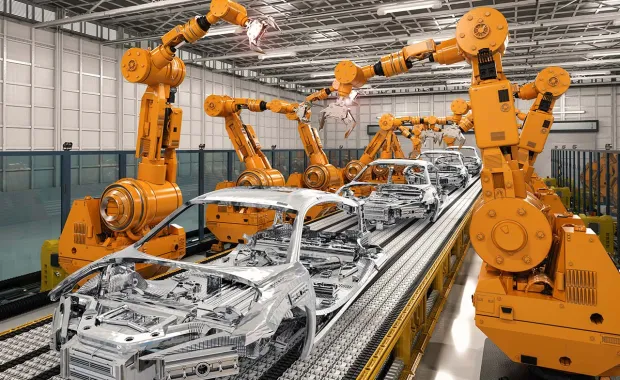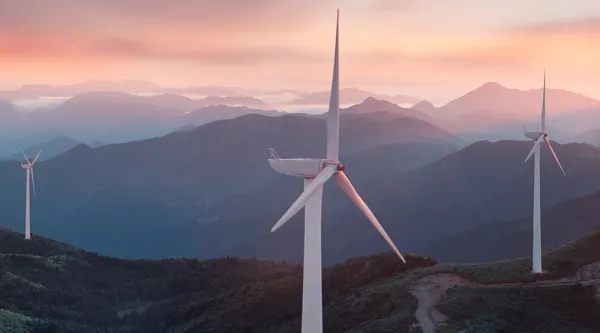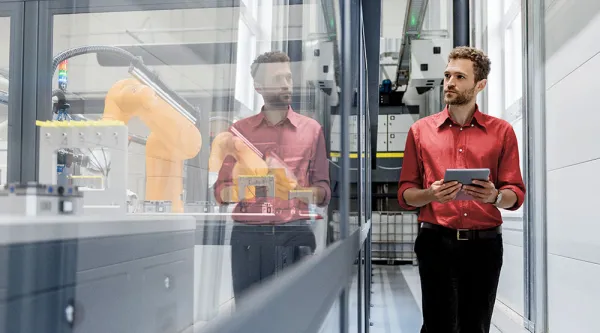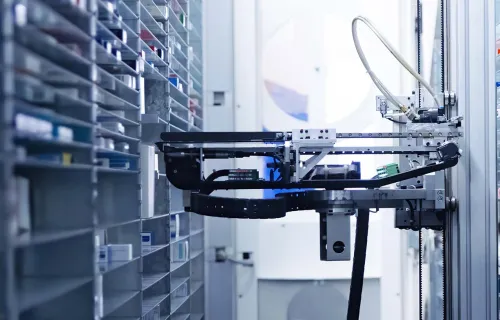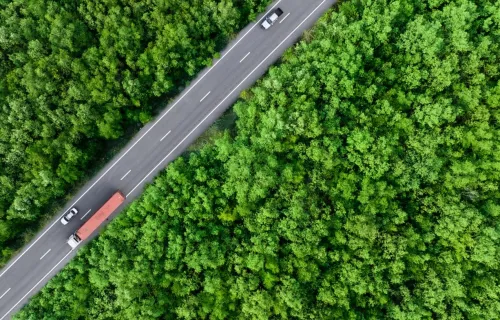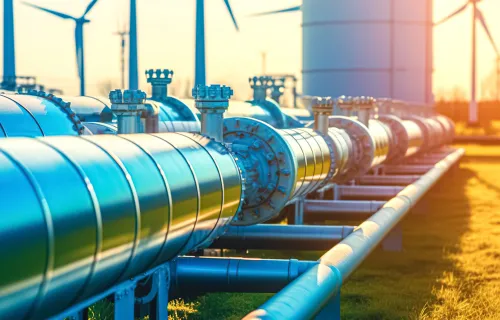"Manufacturing is at a turning point," says Helena. In the last decade, the industry has focused on Industry 4.0 objectives of digitizing processes, achieving operational excellence and making the business more agile. Due to the accelerating climate crisis, sustainability has become a key factor that manufacturers need to consider, which complements the European Commission's definition of Industry 5.0 and its focus on human awareness and sustainability.
Governments and legislation are pushing organizations to meet 2050 net-zero greenhouse gas emission reduction goals. At the same time, the long-term effects of the pandemic continue to plague the industry. "We live in such a volatile or VUCA (volatility, uncertainty, complexity and ambiguity) world" says Helena. The energy life cycle has become very complex. "There are multiple benchmarks, including technical, social, economic, and environmental aspects," she adds. Technology can be an enabler and accelerator of environmental sustainability within manufacturing. "Especially data analytics can support multi-criteria decision-making in real-time for energy planning, optimization and consumption."
She also notes that players in the European aviation industry have been looking at alternative propulsion technologies for a few years now. These explorations are around electric options for short-haul flights, with hydrogen likely winning out for long-haul journeys. "There's really a revolution going on, though not immediately, because you have long development cycles, especially in aerospace," she says, adding that this transformation will include huge process and system design changes.
However, this shift will also require supporting infrastructure. With many companies committing to 2050 as their climate-neutral targets, Helena says it will be interesting to see how fast the industry evolves to meet them: "I think infrastructural changes need to be accompanied by governmental policies and structures to speed up the process."
Global supply chains need to become more resilient by adopting local sourcing and distribution models and sustainability principles in a circular economy. Helena cites the example of additive manufacturing, broadly also known as 3D printing. As supply chains face immense pressure, "It is a game-changer in product design as it results in lower costs related to producing complex shapes and a lesser need for assembly, shorter time frames, and reduced material costs," she says. She adds that it is worth considering additive manufacturing more seriously as it has the potential to reduce global energy use by 5–27% in 2050.
"It's also about how we as an industry find good ecosystems and ways of collaboration to create a circular economy where you can bring back the parts that you can refurbish, remanufacture, or reuse, thus respecting the limits of our planet," she states. A good example is the European Commission's initiative to introduce "digital product passports" to collect data about a product's composition to improve the chances of it being recycled, reused and disposed of correctly.
Building successful data-sharing ecosystems can help manufacturers unearth untapped potential for new business models and revenue streams and advance environmental sustainability agendas. "Michelin, for example, has partnered with several organizations to build the Better Driving Community initiative that uses driving data to support smarter, safer and sustainable mobility." This data, she explains, can be shared with road maintenance teams, insurance companies and even energy companies to achieve various targets.
Another example is the Catena-X Automotive Network, set up to create standardized data and information flows along the entire automotive value chain. "It is really a data exchange platform where all the participants have sovereignty over the data," Helena shares.
"Every company looking to become truly data-driven needs to treat the data as a product,” she adds. This requires first having an IT or enterprise architecture in place.
The manufacturing industry is experiencing an acute labor shortage as the baby boomer generation gradually retires. A clear sustainability agenda also can help manufacturers attract and retain the younger generation entering the workforce. "They are looking not just for companies that offer the latest technology stacks, but also have a purpose-driven culture that includes caring for the environment," says Helena.
- Chapter 1: Introductions
-
Peter Warren:
Hello everyone and welcome back to another session on our continuing conversation about the new energy economy, the new energy supply chain and how things are actually changing. Today, we're going to take a look at manufacturing, the traditional manufacturing world and the changing of the untraditional manufacturing world and how it evolves and how that's going to impact energy, what we do, what we make, where we ship it, where we use it and the lead for global industry for energy and utilities. We have my counterpart for manufacturing, Helena Jochberger. Hello, Helena.
Helena Jochberger:
Hello, Peter. Thanks for the invite and a pleasure to be with you here in this podcast.
Peter Warren:
Do you want to give us a little background on yourself and how you got to here?
Helena Jochberger:
Absolutely. I joined CGI half a year ago. However, I have a broad, I would say manufacturing, aerospace and defense background during the last 15 to 17 years, always in the consultancy area. My core processes, or core “know how,” I would say lie in the PLM (product lifecycle management) engineering, manufacturing, supply chain and the maintenance repair and overhaul.
- Chapter 2: Sustainability is transforming the manufacturing industry
-
Peter Warren:
That's perfect for what we're going to be talking about today, then. Thanks very much for that. Actually, I knew that already, but that's good to know again for our audience. We've got a change here. How do you see green technology affecting your industry? How is your industry adapting to this whole demand of green energy?
Helena Jochberger:
Yeah, thanks for asking. And indeed, I think we are really at a turning point of transformation and manufacturing. It seems to be the next chapter. For 10, 11 years, we are constantly talking about Industry 4.0, meaning that we are digitizing all the processes, making operations more excellent, more business agile. I think, due to the climate crisis over the last years, there has been a new component added to the game and that is called the sustainability component, of course. And the interesting fact is also that the European Commission last year launched a white paper exactly on that new term — Industry 5.0 — that takes into account all the concepts that we knew before from 4.0 and complements it, on the one hand, with the sustainability and on the other hand, with the human awareness factor.
- Chapter 3: Digital twins enable energy saving targets
-
Peter Warren:
That's very interesting. I think this is sort of a combination of evolution and revolution as people start to look at new technologies. What's your thought on digital twins and how that's going to play a role here?
Helena Jochberger:
Yeah, absolutely. I think they are two brothers and sisters called, right? On the one hand, you have the smart factory aspect and that is going to be combined with the sustainability aspect. And digital twins are, at least to my point of view, really an enabler for energy saving targets. Creating a finer granularity on the machine level can really support achieving energy saving targets. The digital twin along the value chain is really a good example of how manufacturers can get a clear picture of actual performance through the digital twin and they can improve their situational awareness and operational flexibility. The equipment energy consumption is really a large part of the total manufacturing energy consumption, and therefore can really benefit from the smart use of digital technologies.
- Chapter 4: The importance of automation and the human factor
-
Peter Warren:
If they're doing this and they're looking to this point, is there a new increase in automation and how that's going to impact them, or do you see this also being more of a human factor, as well?
Helena Jochberger:
The human factor was, and remains, a crucial part of the story. It has also changed because we are tackling all that general challenge of a lack of talent in the future. I think the companies that are able to answer to the younger generation that is entering the workforce and giving them purpose and caring for our environment, they will be more likely to attract talent in the future. I think technology always goes hand in hand with that sustainability aspect and giving purpose. Because young people coming from the IT bachelors, IT masters and so forth, they're selecting the companies that are not only giving them the latest technology stack, but also the purpose. So, I think it's both.
- Chapter 5: Complex supply chains of the future rely on data analytics
-
Peter Warren:
Yeah. I think that's a key factor. I know that something else we published was about neurodiversity and truly appreciating that as a change. As we all compete for talent, people need to know what we're standing for and what we're doing. It comes up in interviews now. People want to know, not just vacation time and pay, they want to know what are you going to do for the world? How is this going to change things? And I think our clients have to apply that, as well.
This whole energy life cycle has become very complex. There's also an aspect that governments and policies have all set the same goal date. Everybody's decided to have everything completed at the same time. There's a lot of physical things besides process things that need to be done. How do you think the manufacturing industry is going to have to respond to this and also do it in a green fashion?
Helena Jochberger:
I think a good example for that is the whole discussion around the supply chains of the future. We are still recovering from the effects of the pandemic. Therefore, I think we are living in such a volatile and VUCA (volatility, uncertainty, complexity, and ambiguity) world, as a lot of people say. And it's really necessary to think in scenarios and multi-criteria.
Current energy blending has become really complex as you said, Peter, with multiple benchmarks, including technical, social, economic, and environmental aspects. I think technology may help here as well, especially data analytics that is considering such multi-criteria decision-making can support in real time with the energy planning and also with the energy optimization of the energy consumption. This is really valid for all the stages.
When you're taking, for example, an automotive manufacturer that is sourcing steel within his production process, it's always the question, okay, how do I source the steel? How is the steel being produced? Is it produced based on hydrogen? Is the hydrogen really a green hydrogen? Then the question, how is the steel being transported to the tier one suppliers? How are the parts manufactured? What kind of waste is being produced during the production process? How big was the energy consumption? And then of course downstream, when you go to the final assembly of a car or an aircraft, the same questions apply. As you can see, a really complex process and again, a data analytics and advanced analytics may really help us in solving these questions.
- Chapter 6: The importance of additive manufacturing
-
Peter Warren:
In our other conversation, getting ready for this call, we talked about the circular economy. Looking at a supply chain where you use and consume things where you are, reuse things, don't discard things, don't ship things halfway around the planet. Do you see there's new technologies moving forward to be able to have production done a lot closer to home and maybe more just in time?
Helena Jochberger:
Yeah, absolutely. I think we can name here the example of additive manufacturing, or more broadly known as the 3D printing, that has already been a game changer. For example, in product design, implying less costs in producing complex shapes and less need for assembly, so therefore less time and material costs, and so forth. This concept of additive manufacturing really shortens the product development cycles and reduces manufacturing cost and lead time, especially in times when supply chains are being impacted heavily.
It's worth considering additive manufacturing, even stronger, keeping in mind also, for example, prognosed reduction of 5% to even 27% of the global energy demand that is achievable with the adoption of additive manufacturing.
While we are also speaking about the circular economy, yes, this might be for sure a concept and especially for the circular economy again, it's the design, it's the producing, it's the shipping. And it's also the aspect with the user at the end of the day. How is the user behavior and how might we as industry find good ecosystems and ways of collaboration to create a circular economy where you can bring back the parts in a way that you can refurbish, remanufacture, or reuse, thus respecting the limits of our planet?
- Chapter 7: Innovating data ecosystems for sustainability
-
Peter Warren:
We've talked about globalization. Globalization was the big thing, ship everything around the world. Now, to be greener, it's: use and consume much closer to home and reuse. I think that the concept of this is to really do this at home, to truly do this, to truly recycle, that is going to put different demands on the energy suppliers. If it's all done by, let's say clean electricity, there's going to be a more local clean electricity, but there's going to be more jobs, more careers, more opportunities. Do you have a good example of somebody or a group of companies that are teaming up to do innovation? I think there's a lot of people looking at teaming up with people that they might not have done in the past to come up with innovations. Do you have a good case account of that?
Helena Jochberger:
Thanks for asking. I think the whole concept about data ecosystems and also data ecosystems in use for sustainability or energy topics is really a trendy one at the moment. To name both, for example, we work together with Michelin. And Michelin has placed into reality the Better Driving Community where they have partnered with third-party participants that have never partnered before.
Michelin per se, is a tire manufacturer, right? And with the data that they are collecting on the streets and that they are providing to, for example, road maintainers in France or insurance companies, or also energy companies, there can be achieved various targets. First of all, the roads get safer, there are less accidents on the streets and the roads are better maintained. Also, with the help of geo satellite data, you can bring into that whole story a lot more aspects.
Another example would be the Catena-X initiative founded in 2021 by originally German car producers. And that is really expanding throughout Europe. The Catena-X initiative is really a data exchange platform where all the participants have sovereignty over their data. And with the help of defined standards, they're exchanging the data for dedicated working groups. To name only one of that, which is also the circular economy, material passports are being created for parts of electrical vehicles, allowing then in a second step, in a community with third-party participants, to share that material passport and thus enabling the parts being re-brought to the manufacturing and to the recycling cycle.
- Chapter 8: Generating revenue from IOT infrastructure
-
Peter Warren:
Yeah, that's very fascinating. As driving changes and we move to an IOT-driven platform on the highways and ultimately, if it all works out, autonomous driving, at least at some level, there were questions about how do electric vehicles pay for the use of roads? A lot of petrol taxes, road taxes are built into the use of gasoline. And at the moment, a lot of places are not capturing the road maintenance. One of the dialogues we've been having with another group is sort of a pay-per-use.
How is a municipality, a government, a state, a province going to pay for all of this IOT infrastructure and maybe a pay-per-use as people use it, drive down and have a safer experience. And the IOT devices of a tire telling them where the potholes are and everything else is an interesting concept. Anything to add to that? Have you considered that as a thought?
Helena Jochberger:
Yeah, absolutely. I mean, that's the concept of using data as a service or using data as a product. I think every company that deals with the thought of becoming truly data driven, and in my case, it would be the manufacturing companies, they need to treat the data as a product, otherwise this will not work. To really implement such, I would say new revenue streams, of course you have to have your IT or enterprise architecture, first of all, in place to prepare for such a future. Then you can start off and set up the new revenue models and your new revenue streams.
- Chapter 9: Alternative energy in transportation
-
Peter Warren:
The airline industry is an interesting one, too. Airbus is looking at different things, different technologies. I know the other folks are doing the same things. How do you see the shift in transportation fueling coming into play or transportation energy?
Helena Jochberger:
Yeah, it will be for sure a huge shift. When you look, for example, into Airbus — and this is the European aviation industry I know best — Airbus is looking, for a couple of years now, for alternative propulsion technologies. And there's still the best guess for whether to use, in short-range planes, more than electrical aspects of the story. Whereas for sure, for long-term flights, there will be the hydrogen concept that has the highest chances to win, I would say. For sure, there's really a revolution going on. Not immediately, but because you have long development cycles, especially in aerospace, however, I would say until the first hydrogen-based aircrafts will fly, we will be at 2035, best guess. This is, at least, what Airbus has announced. And we will see huge changes, both in product design and systems design.
Of course, you have to think about the change of the infrastructure at the airports. How can we supply the infrastructure for these hydrogen-based aircrafts and so forth? For me, it's really interesting to see how the industry will be evolving and also how fast, because as you know, Pete, a lot of companies have given themselves the goal to be energy neutral by 2030. And for me, it's always the question, how fast are we able as industry to turn the switch for a better and greener future?
Peter Warren:
It's very interesting. I remember a great book written years ago called Blindsided and the concept behind that is your competition isn't always necessarily the people that you suspect today. It could be someone else coming into this. As hydrogen could be made locally and then sold to an airline at the airport — it could may be made, consumed, produced there perhaps in different ways — that's going to be an impact. Electric aircraft are already flying in BC, British Columbia as commuter planes, as sea planes. Therefore, there has to be new electrical infrastructure put into the docks for them, something that was never envisioned before. Instead of gas pumps, they have big charging stations.
It's going to make a major change. Therefore, I think that the suspicion of who your competition is for our side is going to be interesting because certain manufacturers, if you look at Tesla having charging stations, they're competing with the petrol stations, in a way. And they're also who think that they should be owning the charging stations. But then of course, other manufacturers — German ones— are looking at the same ideas. This is going to be an interesting shift. Any thoughts on that? Otherwise, we'll move to a bit of a wrap up and close things down. Any thoughts on that last bit?
Helena Jochberger:
Yeah, absolutely. I had an interesting client meeting the other day with a big battery manufacturer producing exactly the batteries for electrical vehicles. It's really interesting to see how fast these kinds of gigavolt factories are now being implemented and how big the thirst is coming from the automotive industry, for example. I mean, as always, I think infrastructural changes need to be accompanied by governmental policies and structures in place in order to speed up the process. That would be my comment on that one.
- Chapter 10: Consumers can drive industry change
-
Peter Warren:
Okay. That's great. Well, thank you for that. It's been a joy talking to you about this, because as we looked at the banking industry, now we have view on from a manufacturing standpoint, the financing of all this is going to be a key function of it, the actual physical construction of things, deployment of things, the IT to run things are all going to be key components. I'll give you the last word. What would you like to leave as a final thought?
Helena Jochberger:
Thank you. One final thought is still becoming really conscious about what we do in the industry. It's funny that you're mentioning Andy (Schmidt), because I was also talking to Jean Baptiste (Branquart) when I met him in Lyon and we were chatting about this fast fashion industry and how we, as consumers, can do our teeny tiny part to make the industry change. Because I think the more pull you have as a consumer, the more the industry will react. And this is the part that all of us can do in a personal way.
Peter Warren:
That's perfect. Well, thank you very much. Appreciate you joining today and thank you everyone for listening. And we'll see you at the next one. Bye-bye.
Helena Jochberger:
Thanks everyone. Bye-bye.
